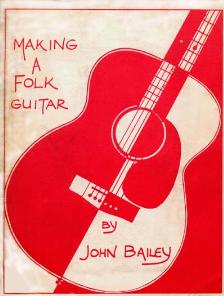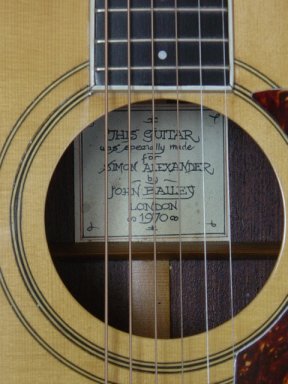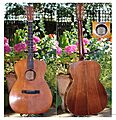John Bailey (luthier) facts for kids
Quick facts for kids
John Bailey
|
|
|---|---|
| Born | 1931 England |
| Died | 2011 (aged 79–80) |
| Occupation(s) | Luthier |
John Bailey (1931–2011) was a talented British luthier. A luthier is someone who builds or repairs stringed instruments like guitars. John made and fixed guitars and other instruments. He was very active during the 1960s, when English folk music became popular again.
John lived in London until 1972. Then he moved to Dartmouth in Devon. In the late 1970s, he returned to London. For a while, he helped organize a course at Merton College. This course taught people how to repair musical instruments.
However, John preferred teaching his skills to students. He was happiest in the classroom. So, he moved back to Dartmouth. He continued making instruments there into the 1990s. John started as a woodwork teacher in Hendon. He made instruments in his free time. His early business card even said "Albert John Bailey – Violin Maker."
Contents
Books by John Bailey: Learn to Build Instruments
John Bailey wrote two helpful textbooks about making musical instruments. These books were called Making a Folk Guitar and Making an Appalachian Dulcimer. They were published by The English Folk Dance and Song Society at Cecil Sharp House.
These rare booklets are part of The Folk Shop Instrumental Series. They are full guides on how to make acoustic folk-style instruments. The books include detailed drawings. John's wife, Maurine, designed the covers. Russ Woolnough took some of the photographs.
George Lowden, a famous Irish luthier, shared how Bailey's book helped him. He said it was important when he started his career.
1973 – After a fair bit of prayer! (I needed all the help I could get) I decided to make guitars professionally and armed with some wood, basic woodworking tools and an excellent booklet by English Luthier John Bailey, I began the journey.
Famous Musicians Who Played Bailey's Instruments
Many well-known musicians have played instruments made by John Bailey. His guitars were loved for their sound and craftsmanship.
Bert Jansch and His Bailey Guitars
Bert Jansch was a famous folk musician. His first guitar was a Zenith. Later, he got a handmade guitar from John Bailey. Bert loved this guitar, but it was sadly stolen. After leaving his band Pentangle, he got a Yamaha guitar.
Bert also owned an experimental electric guitar from Bailey. He used it with Pentangle. John Bailey also made Bert a twelve-string acoustic guitar. This special twelve-string guitar is now owned by Soren Venema. Soren runs Palm Guitars in Amsterdam.
Gordon Giltrap's Long-Lasting Bailey Guitars
Gordon Giltrap is another well-known guitarist. He often said that his Brook guitars reminded him of his John Bailey guitar. He used his Bailey guitar for many years and on many albums.
Gordon shared his sadness when John Bailey passed away in 2011. He called John one of the "great pioneers of guitar making" in Britain. Gordon still owns a stunning twin-neck guitar that John made in the late 1960s. He bought it around 1975 and used it a lot.
Gordon's first Bailey guitar was bought new from John in the late 1960s. John sold it to him for a very low price, showing his generosity. Gordon used this guitar throughout the 1970s and early 1980s. It appears on many of his recordings, like Heartsong.
Gordon remembers seeing Bert Jansch play a John Bailey guitar at Les Cousins. He immediately wanted one. He even asked Bert about the guitar, which was their first conversation. John Bailey also gave Gordon a beautiful Appalachian Dulcimer as a wedding gift in 1970.
Other Musicians and Their Bailey Instruments
- Roy Harper: John Bailey made a guitar for Roy Harper years ago. Roy still uses it. He loves its unique sound, even with its quirks.
- Richard Thompson: Richard used a John Bailey acoustic guitar until 1972. He often borrowed guitars from friends or used his producer's Martin D28.
- Al Stewart: John made a black six-string guitar for Al Stewart in 1967.
- Marc Brierley: Marc asked John to make him a guitar in 1966. Bert Jansch recommended John. Marc visited John's house every Saturday to see the guitar being built. He loved the guitar, which cost him £80.
- Anthony Phillips: The former Genesis guitarist played a Bailey six-string on a demo recording in 1973.
- Colin Wilkie: In 1965, John Bailey custom-built a beautiful six-string guitar for Colin. Colin has used it constantly for many gigs, TV shows, and recordings. He also made Colin a 12-string guitar and a six-string mountain dulcimer.
- Colan Campbell: The former guitarist from the Australian folk band Extradition owned an experimental six-string guitar from John Bailey. It was stolen in Paris in the late 1970s.
Images for kids





